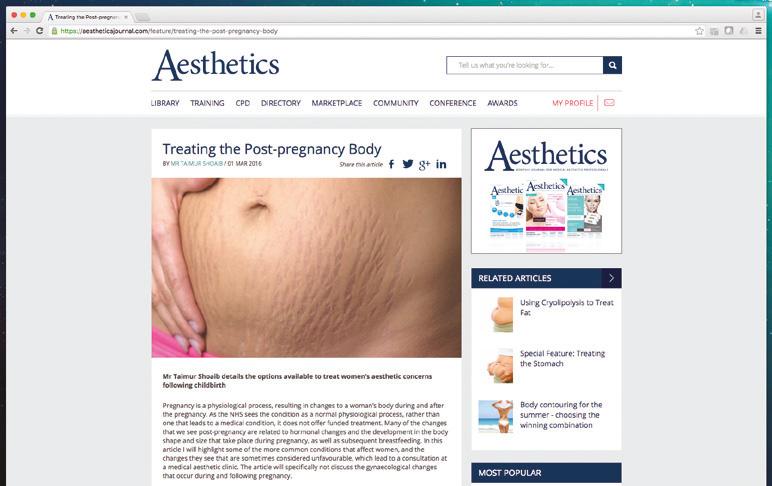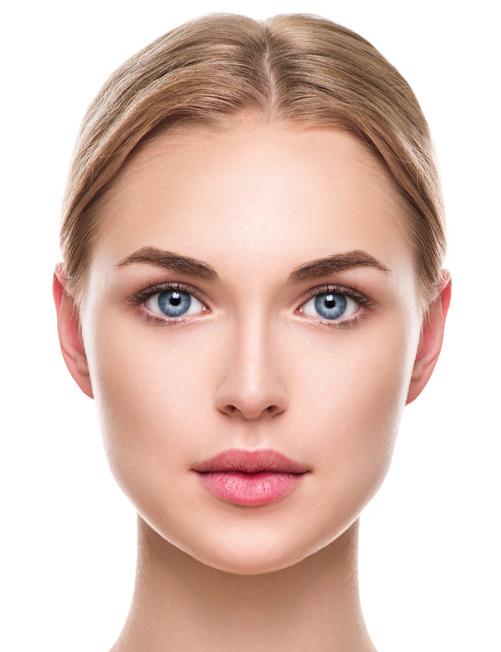
7 minute read
The Last Word
Dr Ruth Harker argues why she believes dermatology training is essential in aesthetic practice and why many practitioners need to become better educated
Dermatology is the study of the structure and the functions of the skin, the diseases that can affect it and their management. It includes topics from skin cancer to skin ageing and common diseases such as acne, eczema, rosacea, psoriasis and rashes, as well as psychology. It is a vast area of medicine and one that many dermatologists devote their lives to. Non-surgical aesthetic nurses, dentists and doctors are looking, touching, feeling, assessing and treating the skin on a daily basis; however, many don’t have training in dermatology; in other words, skin. Here I am going to explain why I believe this is a problem, and what we can do to solve it.
Advertisement
The issue The skin is the largest organ in the body with a complex, five layer structure that performs many functions. It has a barrier function; literally keeping the outside world out and being waterproof so the body tissues do not become waterlogged. It has a protective function and covers the body’s contents, a defence action to cold, controls sebum production, contains various types of nerve sensors for pain, pressure, heat and cold, and has an immune function, amongst other important roles. Many rashes and lesions, for example, are manifestations of occult systemic disease and genetic disorders. 1,2 However, if an aesthetic practitioner does not have training in this area, then it can put patients at risk. For example, if the practitioner cannot diagnose a skin cancer, is this satisfactory for patient care? Some aesthetic practitioners are consultant dermatologists or dermatologists in the hospital training grades, while a number of GPs perform extra study and practice to become GPERs (GPs with extended range). 3 These doctors will have had a minimum of nine years’ training, with others having a lot more. Some nurses may work in a dermatology department of an NHS hospital, privately for dermatologists or in a mole clinic, so have learnt much during their work. Other nurses and doctors may have a postgraduate Diploma or Master’s in clinical dermatology. Obviously, these practitioners are in a good position to diagnose and treat the skin. However, the fact is that the majority the British Association of Cosmetic Nurses (BACN) offer good guidance to direct candidates to the best accredited courses. BCAM has a new exam for full membership for dentists and doctors and will have a detailed module on dermatology. 4 There are also specialist dermatology groups such as the British Association of Dermatologists
of aesthetic practitioners are injectors; some with only a day or two of group injectable training. The standard of the training courses may vary and, very often, they do not include much dermatology education. The concern is that while these practitioners may be skilled injectors, they may miss an important diagnosis relating to the patient’s skin health. I believe that the rationale that aesthetic practitioners should have dermatology promotes thorough further training of fully
training is undeniable; there is no possible reasoning for us not to have it.
Medical students do receive some education in dermatology; between two to six weeks depending on the medical school, and perhaps may perceive that this is adequate to specialise in dermatology and treat dermatologic conditions. However, only a small percentage of doctors will have a post-graduate qualification in dermatology or a hospital post in dermatology. Some doctors now aren’t committing to the usual three-year hospital training after medical school and want to go straight on to become an aesthetic practitioner. So, although they will have the title ‘Dr’, they may have practised little medicine or dermatology. Similarly, it’s common for many nurses and dental students, unless they have
Colour Text, 6e Paperback – Illustrated, 2016. 3. British Association of Dermatologists, Diplomas and Courses for independently sought additional training, to gain little dermatology training. I don’t believe this is enough to work in aesthetics and more is needed. Alongside this, as injectable treatments are inserted under the skin, many practitioners may believe that dermatology knowledge isn’t important. However, as mentioned dermatology is vast and includes treatments that are performed under the skin.
The solution Seek to gain a Diploma or Master’s in dermatology. There are also various Level 7 courses in aesthetic medicine, which include dermatology, so I recommend that practitioners pursue a course that includes this. I also believe that the ultimate aim is that all aesthetic practitioners – doctors, dentists and nurses – will achieve a Level 7 qualification. Associations such as the British (BAD) and The British Dermatological Nursing Group (BDNG) which can assist practitioners looking to educate themselves in dermatology. In addition, there are many good textbooks for further reading 1,2 and some aesthetic training providers that have specialist courses in cosmetic dermatology, which I believe can also be useful for aesthetic practitioners. 5
Summary My views are endorsed by the BCAM, which qualified doctors and dentists to ensure that they are the correct practitioners to treat the general public for cosmetic procedures. The Joint Council for Cosmetic Practitioners (JCCP) is composed of representatives from BCAM, the BAD, BAPRAS, BAAPS and the BACN and is striving to achieve agreement on clinical standards for patient safety, acceptable to the relevant regulatory bodies. 6 If aesthetic practitioners are educated in dermatology, then I believe they are providing a better and safer service to their patients. It should of course be emphasised that practitioners should never treat outside of their skillset – always refer to a suitable professional.
Dr Ruth Harker has been a GP and has been a dermatology hospital practitioner performing minor surgery for many years. She has a diploma in practical dermatology and is medical director of the Erme Clinic. Dr Harker is the conference and finance director for the British College of Aesthetic Medicine.
REFERENCES
1. Baran R & Mailback H, Textbook of Cosmetic Dermatology, Fifth
Edition (Series in Cosmetic and Laser Therapy) 2017. 2. Gawkrodger D & R Ardern-Jones M, Dermatology: An Illustrated
College of Aesthetic Medicine (BCAM) or
General Practitioners. <http://www.bad.org.uk/healthcare-professionals/education/gps/ diplomas--courses-for-general-practitioners> 4. BCAM to implement exam for Full membership, Aesthetics journal. <https://aestheticsjournal.com/news/bcam-toimplement-exam-for-full-membership> 5. Harley Academy, Cosmetic Dermatology. <https://www. harleyacademy.com/training-courses/cosmetic-dermatology/> 6. Joint Council for Cosmetic Practitioners (JCCP) and
Clinical Standards Authority. <https://www.bacn.org.uk/ documents/jccp/JointCouncilforCosmeticPractitionersJCCP
CSAGenericPresentationV1.pdf>
AESTHETICSJOURNAL.COM

Stay up-to-date with all the latest news and more!

Post, search and view job prospects and classifieds in the MARKETPLACE
Browse the comprehensive supplier and distributor list in the DIRECTORY Add, search and record your medical aesthetic development in TRAINING
Read accredited articles and receive digital certification of your learning in CPD


Search a huge range of categorised content for your specialism in the LIBRARY
When you want to define the lower face, there’s a new, structural gel that allows you to focus on the chin and jaw area. 1–3

with Juvéderm ® VOLUX 1, *
Juvéderm ® VOLUX can restore and create facial volume 1,† in the chin and jaw area for 18–24 months. 3,4,‡
Model treated with JUVÉDERM ® . Results may vary. * Juvéderm ® VOLUX contains lidocaine. 1 The addition of lidocaine does not alter the physical properties of JUVÉDERM ® products. 5 †No available controlled clinical data on the effectiveness and tolerance of Juvéderm ® VOLUX injection into anatomic regions other than the chin and jawline. 1 ‡Based on comparative preclinical testing and results from repeat treatment data, added to Juvéderm ® VOLUX clinical study showing duration beyond 18 months after initial treatment or initial + top-up treatment in the chin and jaw, and based on clinical results for Juvéderm ® VOLUMA with lidocaine showing 24 month duration in the mid-face establishes Juvéderm ® VOLUX as having an in situ duration of 18–24 months. 4
1. Juvéderm ® VOLUX DFU. 72778JR10. Revision 2018-07-26. 2. Allergan. Data on File. INT/0663/2018. Juvéderm ® VOLUX final clinical evaluation report. Oct 2018. 3. Allergan. Data on File. INT/0654/2018. Juvéderm ® VOLUX final clinical study report & clinical evaluation report – efficacy and duration data. Oct 2018. 4. Allergan. Data on File. INT/0074/2019. Juvéderm ® VOLUX final clinical evaluation report, July 2018. Jan 2019. 5. Raspaldo H et al. J Cosmet Dermatol. 2010;9:11–15. ©2019 Allergan. All rights reserved. Material developed and produced by Allergan. UK/0203/2019 Date of preparation: April 2019










